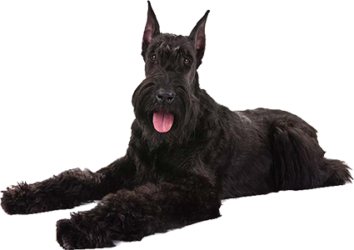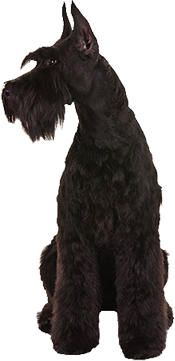Breeding the drive, size, and muscle you see in a working Giant Schnauzer into a dog that will also excel in AKC conformation, and be of the upmost health and vigor. Yes, you can have it all! Our pups make wonderful family pets, working dogs, and excellent therapy/service dogs. Parents are WORKING DOGS on our FARM. We health test our parents for VWB, THYROID, HIPS and EYES. We also champion title many of our adults in conformation. Breeding for protective nature and drive to work.
We have chosen to test our parents for the following. I personally feel all Giant Schnauzer breeders should be testing for the following to improve the breed. I recommend only getting a pup from a breeder that does the health testing and will show you all the results. It is up to US responsible breeders as to what the Giant will be 10 years from now, not just in “LOOKS” but even more importantly in “HEALTH”.
- Eye CERF testing: OFA certification is given on this extensive eye exam in which the eye specialist dr looks with special equipment within the eye and its structures to see if there are any defects that will eventually cause eye problems. We do this eye cerf test early on when we first are thinking we might keep the dog for breeding. If both parents have good eye exams then their puppies have very good chance of also having good eyes.
- Thyroid: Hypothyroidism is the most common endocrine disease to dogs. The thyroid gland controls the speed of metabolism of almost all body cells. When thyroid hormones are subnormal, many different body systems can be affected; so the clinical appearance of the disease can vary. The most common clinical signs include: weight gain, sluggishness, skin and hair coat problems, weakness, cold intolerance, and infertility. Hypothyroidism is not life threatening but it should be tested and cleared from any breeding dogs to stop the genetic factor within the breed which can cause infertility within the lines. We test the thyroid early on when we are first deciding if we will breed a dog.
- Hip dysplasia: is the abnormal development of the hip during growth which leads to increased wear and tear and subsequent deformity of the joint. The abnormal joint may become painful and cause lameness due to arthritic or degenerative changes. All our breeding dogs get OFA certified at 2 yrs of age on hips or get PENN Hip done showing good results for breeding. If the dog is younger than this we will have the vet evaluate the hip by exam before breeding. You can see if hip is deformed even in a puppy… So ongoing hip ex rays are not needed if hips are cleared at 2 yrs of age. PENN Hip can even be done earlier than 2 yrs and the results do not change throughout the dogs life on PENN Results.
- Von Willebrand’s disease: Platelets play a vital role in the blood-clotting process. Why is this so important? If a dog has an injury or wound, the platelets help stop bleeding and speed up the healing process by clotting at the site of the injury. When a dog has too few platelets, wounds and injuries can be really dangerous because he or she might not stop bleeding and lose a lot of excess blood. There’s a name for this: von Willebrand’s disease (vWD), which is a disorder in dogs that is characterized by excessive bleeding due to a defect in platelet function. VWD is a hereditary disease that is passed from parents to pup in a rather complicated way. A dog that is a carrier can be bred to a high ranking non carrier, but if the carrier shows signs of clotting problems it should not be bred. Any offspring should also only be bred to a high ranking non carrier. We test our dogs for this early on so know who to breed them to. All results are seen on our sire/dam page.


